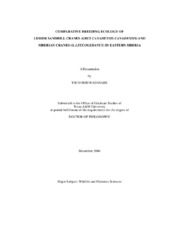| dc.description.abstract | Populations of Lesser Sandhill Crane (Grus canadensis canadensis) have been
increasing during the last decades in Eastern Siberia, an area historically known as
breeding grounds of endangered Siberian Cranes (G. leucogeranus). Significant overlap
in niche dimensions between the two species may occur and could lead to competition
between them. Therefore, this study of comparative breeding ecology of common
Lesser Sandhill Cranes and endangered Siberian Cranes was performed.
From late May to early August 2000, I studied Lesser Sandhill and Siberian cranes
within a 30,000-ha part of Kytalyk Resource Reserve in the Republic of Sakha (Yakutia),
Russia. My main objective was to compare dispersion patterns and resource use of
breeding Lesser Sandhill and Siberian cranes in areas of distribution overlap.
Lesser Sandhill Cranes used moderate-wet (polygon) areas as their nest sites and
main foraging areas, where terrestrial foods were scattered. In contrast, Siberian Cranes
were nesting and foraging on low-basin wet areas, where aquatic foods were concentrated and dominant. Inter-nest distances were less for heterospecific cranes than
for conspecific cranes, and more territorial behavior was projected toward conspecifics
than toward heterospecifics. Lesser Sandhill Cranes were more mobile and used
moderate-wet (polygon) areas more than Siberian Cranes; however, both species spent
similar time foraging and being alert.
The two crane species used different vegetation types for nesting and foraging,
had different time-activity budgets, and used different resources in the Siberian tundra.
While the population of Lesser Sandhill Cranes in the study area has the potential to
increase, both species may simultaneously share the same geographic area due to
differences in ecological requirements. | en |


